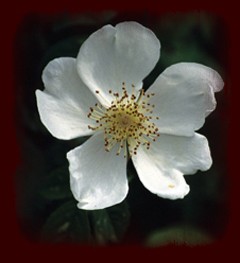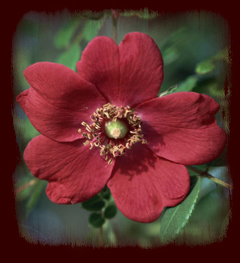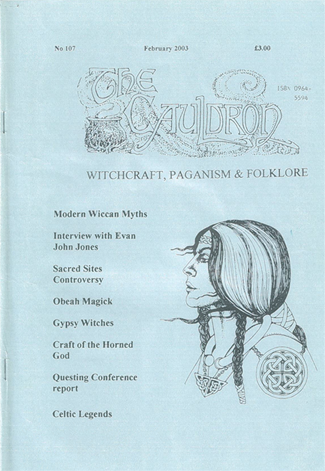
CLAN OF TUBAL CAIN

Interview with Evan John Jones, Published in The Cauldron, February 2003 |
Evan John Jones was a member of Robert Cochrane's coven in the 1960s and is the past magister of the Clan of Tubal Cain. A retired engineer, he served in the Army as a young man and saw active duty as a paratrooper in the Suez crisis of 1956 and fighting communist insurgents in Malaya. Currently he lives in Sussex. He is the author of Witchcraft: Evan John Jones was a member of Robert Cochrane's coven in the 1960s and is the past magister of the Clan of Tubal Cain. A retired engineer, he served in the Army as a young man and saw active duty as a paratrooper in the Suez crisis of 1956 and fighting communist insurgents in Malaya. Currently he lives in Sussex. He is the author of Witchcraft: A Tradition Renewed (Robert Hale 1990), Sacred Mask Sacred Dance (Llewellyn USA 1997), The Roebuck in the Thicket (Capall Bann 2002) and The Robert Cochrane Letters (Capall Bann 2003). Q How did you first become involved with the Craft and with Robert Cochrane? A. I met Cochrane more by accident than design. His wife and I worked for the same firm in Slough. She was in the office and I was on the floor with a firm who were the countrywide suppliers of VW spares. When it relocated, we were made redundant and we bumped into each other in Slough public library. One thing led to another and I ended up being invited over to then place and Fate more or less took over from there. Q. Can you tell us about your connections with the coven in Oxfordshire you knew? A. One of my best friends at school was the son of the Master of the group. In fact we both joined up in the same regiment on the same day. He finished his two years National Service, while I signed on and transferred to another unit. We, of course, met up again after the mob and he, knowing of my interest in the occult, gradually introduced me to the members of their group and I more or less ended up as an honorary one. The only reason I didn't become more involved was down to the fact that they thought Cochrane had something that set him apart from the run-of-the mill Craft, but didn't trust him enough to want a face to face meet. My friend's family had a large estate and had farmed it for generations They were an old coven and Homed God orientated. Q. The 'old English' character of the Tubal Cain tradition here seems very different to that found in the American forms originating from Joe Wilson. Why do you think this is so and what is your opinion of those Americans following the tradition, such as the Roebuck Coven in Los Angeles and the so-called 1734 groups elsewhere in the States? A. I think Joe Wilson and others picked up on the name 'Tubal Cain' in a Craft context then shaped what they found out and shaped the knowledge to suit their own needs and ends, which is fine. But, the trouble is, their version of Tubal Cain has now become gospel to many of them and everyone else is wrong and they are the only ones who are right. If people take basic knowledge and shape it to their own needs, fine. The Craft has always been fluid enough to cope with that as long as it is remembered that it is just their interpretation, and not the absolute truth. '1734' has always, and still IS, a sore point with me, just as it was with Doreen Valiente. [See her chapter on Cochrane In her Rebirth of Witchcraft, Robert Hale 1989] Both of us knew the truth behind it, but others don't want to hear that so I prefer not to think about it any more Q. You have recently retired as magister of the Clan of Tubal Cain and passed the cup and stang to your successors who were originally Gardnerian initiates. Why did you choose non-Traditional Crafters for this important role of carrying on the tradition into the 21st century? A. 'Gardnerian' was never a dirty word m my book, though I must admit that to Cochrane it fell somewhere between sodomy and bestiality and, if he had been around today, supporting Tory Blur. Most of the traditional mobs I know are finally locked into their own cycle of rites and beliefs so why should they want to take the Clan on board? When I first met Shani (the new maid of the Clan of Tubal Cain) instinct told me she was the one who could run with Tubal Cain, something I'd not felt with others I'd considered. To date I have seen nothing to make me change my mind as she has made it hers and the group is now growing faster then it ever did in the past, which must say something. Q. What are your hopes (or fears!) for hte development of the Clan in the future? A. I hope it will carry on and grow. The one thing that would disappoint me though is if I came back in 50 years time and found it unchanged. Because it would mean that Tubal Cain had become static and hidebound, instead of moving with the times it was in. I would like the Clan to break with Cochrane and myself and in the future it should be doing its own thing and not what we said or say. However that does not mean abandoning the core concepts of the tradition. The basic tradition is there and should remain unchanged, but what people do with it should be the important thing. Q. Robert Cochrane passed to spirit in 1966. What made you decide to write your first book in 1990, after nearly twenty-five years had gone by since his death? A. I decided to write Witchcraft: A Tradition Renewed because there was so much garbage about and I thought that at least I had a better brand of garbage! Seriously, I just didn't have the desire or time to write the first book. You have to want to do these things and it just wasn't there. Then it was, and I wrote it, as simple as that. Q. What are your thoughts about the other forms of traditional witchcraft that feature in articles published in TC? A. They are interesting as you can see things from other people's points of view. There are other viewpoints apart from my own and it is interesting to compare and even learn from others. You will be surprised how much common ground there is between different forms of Traditional Craft. You often come across things from other traditional groups that you are familiar with and one starts to realise that many of the things you knew as secret to your particular group aren't all that secret. This goes to prove after all that many of the basic tenets of the Old Craft were more widely shared than people like to admit. On this score alone I rate TC very highly and would recommend it to anyone. Q. Some other modern groups have claimed to be working with Cochrane as an ancestral spirit guide since he passed over to the Other Side. Do you believe that he has become one of the Hidden Company and how do you feel about these claims? A. It is quite possible that Cochrane is in spirit contact with other groups, but I have my doubts and I'd want to see a lot more evidence of this than I've been presented with so far. I'm not saying he isn't around, but I've heard so many claims that one could only say he's a damned sight busier in death then he ever was in life that's for sure. Q. Is it possible for you to tell us anything about the ritual of solitary vigil practised as part of the initiation into the Clan in the past? To your knowledge did it ever feature the use of (natural) drugs to induce vision? A. For a start, we never used drugs to induce vision. That was a no-no right from the word go. When it carne to any vigil trance working it is never easy to describe because it is so highly individual. I've tried it and nine times out of ten it was a dud, but there again Robert always claimed I was as about as sensitive as a concrete block, so perhaps I'm not really the best person to ask. Q. Could you tell us about the symbolism of the traditional stang in the circle? What does it represent? How is it used to define or mark the changing themes of the seasonal festivals in Old Craft practice, as you know it? A. The coven stang stands in the north guarding the gateway to the Otherworld. It is always the traditional ash stang and is horned at one end and shod with iron at the other. Representing the God-King of the woodland glade, it also symbolises the reincarnated spirit of the Old King in the Young Horne Child from the mother aspect of Diana of the Greenwood. Stood at the edge of the circle, it also represents the guardian of the gateway to the circle, the link between the worlds of the Goddess and spirit and this world. When the feast is held after the rite just outside the circle, by turning the stang to face outward it then represents the Horne Child presiding over the feast honouring the Goddess and the Old Gods. Dressed with arrows and garlands, it is also used to mark the passing of the seasons. For Candlemass the garland would be of yew to symbolise the death or passing of the Old Year. The May Eve garland should be a mixture of birch, hazel, willow and hawthorn. The feminine birch for birth and rebirth, the hazel symbolic of fertility, fire, divination and knowledge. Finally, willow and hawthorn, usually seen as ill-luck and mourning trees if brought indoors, but on May Day both are considered lucky, providing they are kept out of the house and used to decorate doorways. Lammas is the thanksgiving for all that year has delivered to us and for this the garland would be grain stalks. Hallowe'en, the time to remember our dead. Once more yew would be the correct wood to use. Yew can also stand for rebirth because of its habit of growing new trees from a pinned down branch. In this case it can represent mourning and rebirth, all that we pray will happen to us when we eventually pass over. Q. There is a lot of speculation about how many hereditary witch families or clans still exist in the British Isles. How many do you know of or think still exist? A. Personally I know of eight that I'd be willing to vouch for as traditional as I understand that word. I'm sure there are others about and by saying this clan is genuine and this one isn't is a good way to get yourself terminated with extreme prejudice that's for sure, so I will leave it at that. Q. What is your opinion of Gerald Gardner and his legacy? A. Gerald left a legacy that is still going strong and one that certainly made a great impact on the occult world. Even though I have never been a devotee of his, without him the Craft wouldn't be what it is today. For that reason alone you have to admire the man. Q. The Candlemass rite practised by the Clan and published in TC 100 (May 2001) seemed to have a systematic and structured approach. This is in contrast to claims that Cochrane's rituals were usually spontaneous and ad hoc. Can you explain why this should be? A. This ritual was put together specifically for a bigger group as you would need 20 people. Some of the old rites are difficult to perform today because of a lack of people Ad hoc workings are all well and good providing you are doing them at the coven level. But what happens when the whole clan would work the four major rites? Without a structure or a system about 10 seconds after starting the whole thing would degenerate into total chaos. That is why in the past the quartermen were stationed at the four quarters to make sure that everyone was doing the same thing at the same time. The form and structure of the clan ritual served the same purpose as drill in the Army; to get a large body of people to do the same thing together, that's why it would be well rehearsed. Click here to view the interview in PDF format. |
